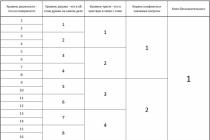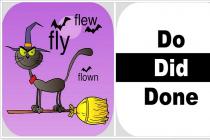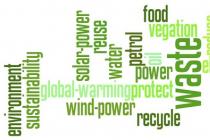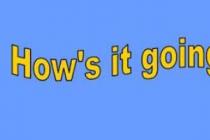). He sent me his results for analysis, putting it this way: “I’m sending statistics, Vladimir, you might be interested.”
To be honest, at first I was unenthusiastic about the idea. Associations, well, associations – you never know what comes to people’s minds... Besides, I was busy, I didn’t have time for that. However, after looking more closely, I realized that something interesting could be discovered here too. This is really true:
Very “bad” data is rare, bad analysis is much more common
Anything was found – both in terms of the associations themselves and in terms of gender differences. I'll just note the specifics of the analyst's view on the received data. If practice(psychologist, sociologist, personnel officer, etc.) are most likely interested in individual associations, then I simply have nothing to do with an isolated case. The analyst is interested mass phenomena. Moreover, the practitioner also, consciously or unwittingly, also compares a specific case with a certain general, albeit vague, image of the “average person.” But such an image is precisely formed on the basis of an analysis of many cases. Otherwise, what are “norm” and “deviations”, despite all the conventionality of these concepts?
Here is a specific example from this sample. There is an association "muffle" with the letter "m". How the hell do you expect me to understand you? Typo? A well-known term, unknown to me due to limited experience? So, after all, a practitioner can also find himself in my position - you never know what comes into a person’s head!
So I had to work on the data - clean it, encode it,... I sometimes used aggregation on the data, which consisted of replacing similar terms with one. For example, I considered “galoshes” and “galoshes” to be one word, just like “tooth” and “teeth.” To the best of my understanding of the situation, grammatical errors were also corrected - I replaced “zorya” with “dawn”, believing the first word to be a simple typo. Of course, I couldn’t catch typos that lead to a meaningful word, but not the one the respondent had in mind, in principle.
But something statistically interesting did come out. What to do with this - think for yourself. Just keep in mind that there are almost 6 times more women in this sample! Therefore, the frequencies produce a very misleading impression - it seems that women are simply crushed. Well, no, it’s not all that terrible...
Although few significant differences were found, how pilot study this attempt should be considered successful.
Analysis of results
So far there are several more topics in the work - “negative-positive”, “state-society”, etc. I will publish as I process it.
Carl Jung used free association as a lie detector because it helped determine a person's motivation. Thanks to this technique, a person can come to the realization of what is gnawing at him and begin to eliminate his psychological problems. The “16 Associations” exercise works similar to Jung’s association test, and it will not take more than 15 minutes to complete. If you want to better understand your own feelings and understand what you really need, Jung’s association test is an unrivaled assistant in this matter.
The human brain is designed in such a way that, if it is necessary to remember something, it is encoded by a set of visual images, information from the senses and associated sensations in the body and emotions.
What will you get from the “16 associations” exercise?
- Awareness of what influences your perception and subconscious attitude towards a situation/phenomenon/fact. Even if you make no attempt to work on the area from which the word was chosen, after 3-6 months you will get a completely different result when you take the test again. This is all the work of the subconscious - when thoughts and associations are put on paper, a person begins to analyze them in any case.
- Transformational effect. Through conscious perception, a change in attitude occurs and there is a reasonable scientific explanation for this. A person remembers not the event itself, but the last memory associated with it. The more new associations we apply to a keyword, the more the circuit that is activated by that word will change. Depending on what emotions arise during associations, the change in the future emotional color of the chain and the feelings that will arise the next time this word is remembered depends. Thus, the brighter the emotion, the stronger the rewriting effect.
- You receive a ready-made map for further work on yourself - it becomes clear what can be used as a resource and what should be changed. The higher the awareness, the more determined a person is to change - this will help achieve maximum results after passing the Jung association test.
Jung's association test: exercise “16 associations”
For the exercise to be effective, it should be performed in absolute peace and solitude.
- Think about what word you would like to work with. For example, if you think that you are currently experiencing financial difficulties, let it be the word “money,” and if you think you are lonely, write the word “love.” Draw the following sign on a sheet of paper:
- As quickly as possible, without hesitation, enter in the left column all the associations that you have with this word - any phrases, catchphrases, words.
- Next, fill out the second column - you need to combine the words into pairs - 1 and 2, 3 and 4, 5 and 6, etc. In the second column you need to enter associations that arise when combining words into pairs.
- To fill the third column, you need to do the same thing - combine the 8 words received in pairs and display associations; we do the same with the 4th column.
- As a result, you get a key word - something with which you can unravel the tangle of problems and get rid of negative attitudes.
How do you like this word? Are you surprised or is this the expected result? How did you feel while doing this task? And was it interesting? Have you discovered something new about yourself?
Quite often it turns out to be a complete surprise what kind of associations can jump out of the subconscious. What can you say about the last word? What does it mean to you?
The general breakdown of the results looks like this:
Analyzing the first column
The first column of words reflects several points at once:
1. Our “level of reality”. This is what fills our daily lives. At the level of reality, our “stamps” “live”, beliefs that have no serious basis, but nevertheless influence our lives.
We think in cliches and these cliches are clearly visible in the first column. For example, if we take the word “money”:
Money is dirt, money is a lie, money is a test, money is pity, money is charity, big money is obtained dishonestly, etc.
It's interesting that money is such a topic that everyone has something to say about. But few of those who talk about money actually have money. Therefore, discussions about money are, by definition, the most stupid. Few of the debaters understand what they are talking about, but nevertheless, everyone has cliches in their heads.
2. At the first level of our test, the strategy for obtaining what we are studying is also very visible. In our example, the strategy for getting money.
Someone is an honest hard worker and his words: “Work, plow, it’s hard, tired, they don’t give it, the boss, the salary...”.
And someone thinks that money should fall from the sky: “I want it, give it to me, a bank, a yacht, a plane, a cruise, an inheritance...”.
Analyze how you are doing with the way you receive money.
The first person from my example will most likely work hard and conscientiously all his life, but if easy money comes into his life (let’s say he receives an inheritance), he will not know what to do with it, and “out of grief” he will get sick or will drink.
The second one will continue to wait for the weather by the sea, be angry that the yachts still don’t arrive, and be offended by the world. But it is unlikely that it would occur to him that money can simply be earned.
It happens that a person has already outgrown the previous strategy, like short pants, but still does not understand that it is time to abandon it. So the Ugly Duckling, who had long ago become a Swan, out of habit hid from the swan flock in the bushes.
3. Also, the first column of words allows you to assess the level of pessimism- optimism regarding your money situation.
To determine it, read 16 words and try to evaluate - as you get closer to the end, do the words become more optimistic or less optimistic?
If the level of optimism goes down - bad! So, as a result of the test, reconsider some of your beliefs and you will achieve success!
If the level of optimism goes up - good! This means that no matter what financial situation you are in now, everything will work out!
4. The next thing we analyze in the first column is - these are induced (transposed, imposed) fears and beliefs on us. Sometimes they are also called “mind viruses.” This is something that for some reason you have adopted, although if you think about it, it has nothing to do with you.
So, parents very often transfer their fears onto their children! A lot of money is a shame.
There is simply a darkness of false and alien attitudes floating in our consciousness! We are saturated through and through with other people's ideas, plans, motives and fears. Now we have a difficult task ahead of us - to catch these OTHERS' problems in our test!
This test should be done by hand on a piece of paper! And this is very important precisely in order to detect “strangers”!
Interesting! People often identify handwritten “virus words” using hidden signs (mistakes, blots, a word is written with a capital letter, and all the rest are written with a small letter, or, conversely, the word is written smaller or larger).
However, analyzing what is written by hand is not the only way to detect “strangers.” Do the following - read the first column out loud, quickly, in one breath, trying to pronounce the words clearly and tracking your emotions and bodily sensations.
Most likely, at some word, a wave of disagreement will rise in you, as if it was not you who wrote it. You may even feel a drop in energy, instant fatigue and apathy.
When you find thought-form viruses on your list, think about their origin. Perhaps you will remember the edifying look of the old teacher, the instructions of the father and the admonitions of the grandparents. But oddly enough, most often we all remember our mother. That's who basically puts everything in our heads.
Now that you understand where it came from and, perhaps, even remembered how much you had to lose or not do because of it, give up this word - belief!
How? Just cross it out and write a new one in its place! Any word, not necessarily close in meaning, but chosen by you personally.
Let's move on to analyzing the second column
The second column is the level of intelligence! That's what I think about it! Let me explain... The fact is that most people do not think about their problems at all. They bathe in them, live in them, worry about them, talk a lot, but think very little! But in vain... Sometimes a good, strong, unemotional analysis would give much more than hours of exciting conversations.
At this level, your own limiting beliefs come out!
Example:
Not sure
Equality
Age
Asking is bad
In decoding it would sound like this:
This won't work for me.
I don’t have enough education... start-up capital... experience...
Wrong age... It's too late... Etc.
Analyze the second column of your test and find limiting beliefs and obstacles in it. If there are any, reflect on them by asking: “Why do I think this is so?”
Each time, ask yourself a clarifying question until you are sure that you have arrived at the absurd. Having caught yourself on the absurdity of the arguments, laugh at them and part with the conviction, like with shoes that have gone out of fashion.
Here is an example of a typical dialogue between a psychologist and a person stuck in his belief:
— Belief: I’m not the same age anymore.
- What is “that” age?
- Well, 20 years.
— When you were 20 years old, what could you do?
- Nothing.
- And now?
- Now I can, I have education and experience.
- So why do you think that the age is wrong?
- Health is not the same.
- What does “that” health mean?
- Young.
— There were rich people in your family
- Yes, my great-grandfather was very rich, he returned from the mines at the age of 40, opened a shop, became a merchant...
— How old was your grandfather when he started, and was he in good health?
Yes, no, he returned from the mines, completely ill.
So it's not a matter of health or age?
- It turns out that yes...
This kind of dialogue with yourself needs to be conducted for every limiting belief. Better in writing.
Let's look at the third column - What is the reason?
The third column is the level of feelings! It shows our “emotional hooks”! “Tails” of the past, fears, causes of emotional conflicts.
Example:
Target
Confidence
Job
Luck
Take a careful look at this column of just four words, and perhaps you will understand the true reasons for not only financial, but also general troubles.
Interesting! From the words of the third column you can usually create an expression - some kind of “slogan” or motto! Play with words and make up a phrase. Sometimes it's an inspiring call to action, even if it's written in capital letters and hung on the wall.
The slogan turned out to be as follows: My goal gives confidence that work will bring good luck
Analysis of the fourth and fifth columns is the key to yourself
What are these last key words for you? Think about it!
There is no standard transcript for the last three words. Usually this is a tool for analysis or a hint for further psychological work. There, a person’s key fears, true and not far-fetched causes of problems, as well as genuine motives can “pop out”. One thing is clear, if the meaning of the words - keys is far from the associated concept (in our example it is money), the root of the problem lies in spheres and planes that are far from the sphere of money as such.
This means that the financial situation will not improve until the real problem is worked out and solved. As a rule, it is organically tied to one of three:
problem of parent-child relationships;
self-esteem;
system of values
Now take a piece of paper and draw the last word!
If it's good, save the drawing! This is your energy resource!
If it’s bad, look at it for a while, say goodbye and solemnly burn it!
The work with the test is now complete. I hope it gave you some useful insights!
Carl Jung used free association as a lie detector because it helped determine a person's motivation. Thanks to this technique, a person can come to the realization of what is gnawing at him and begin to eliminate his psychological problems.
The “16 Associations” exercise works similar to Jung’s association test, and it will not take more than 15 minutes to complete. If you want to better understand your own feelings and understand what you really need, Jung's association test is an unrivaled assistant in this matter.
The human brain is designed in such a way that, if it is necessary to remember something, it is encoded by a set of visual images, information from the senses and associated sensations in the body and emotions.
What will you get from the “16 associations” exercise?
1. Awareness of what influences your perception and subconscious attitude towards a situation/phenomenon/fact. Even if you make no attempt to work on the area from which the word was chosen, after 3-6 months you will get a completely different result when you take the test again. This is all the work of the subconscious - when thoughts and associations are put on paper, a person begins to analyze them in any case.
2. Transformational effect. Through conscious perception, a change in attitude occurs and there is a reasonable scientific explanation for this. A person remembers not the event itself, but the last memory associated with it. The more new associations we apply to a keyword, the more the circuit that is activated by that word will change.
Depending on what emotions arise during associations, the change in the future emotional color of the chain and the feelings that will arise the next time this word is remembered depends. Thus, the brighter the emotion, the stronger the rewriting effect.
3. You receive a ready-made map for further work on yourself - it becomes clear what can be used as a resource and what should be changed. The higher the awareness, the more determined a person is to change - this will help achieve maximum results after passing the Jung association test.
Jung's association test: exercise “16 associations”
For the exercise to be effective, it should be performed in absolute peace and solitude.
- Think about what word you would like to work with. For example, if you think that you are currently experiencing financial difficulties, let it be the word “money,” and if you think you are lonely, write the word “love.” Draw the following sign on a sheet of paper:
Research word

- As quickly as possible, without hesitation, enter in the left column all the associations that you have with this word - any phrases, catchphrases, words.
- Next, fill out the second column - you need to combine the words into pairs - 1 and 2, 3 and 4, 5 and 6, etc. In the second column you need to enter associations that arise when combining words into pairs.
- To fill out the third column, you need to do the same thing - combine the 8 words received in pairs and display associations; we do the same with the 4th column.
- As a result, you get a key word - something with which you can unravel the tangle of problems and get rid of negative attitudes.
If over the next few days you do not let the keyword out of your head, trying to apply it to various areas of your life, then many thoughts may appear that will help you better understand yourself and your subconscious.
When we work with a client’s request in technology, we observe an amazing picture: If we manage to find and work out deep associations on the topic of the request at the very beginning, then often the topic itself is either nullified or becomes very insignificant, which the client can easily cope with. This effect depends to the greatest extent on the therapist’s ability to reach the deep associative connections of the request with the client.
The “16 Associations” technique will help you break through to this deep level, bypassing the client’s mental traps and resistance.
“16 Associations” is an exercise from the field of psycholinguistics aimed at finding your deepest association to one word or concept that is important to you.
Our brain is designed in such a way that when we need to remember something, it is encoded by a set of visual images, information from the senses and associated emotions and sensations in the body - that is, what is already in our long-term memory. Moreover, all these “pieces of memory” are also, in turn, encoded by a similar set, which is why the activation of one of the memories activates entire circuits. These are associations and chains of associations.
Using the “16 Associations” exercise, you can pull on a chosen keyword, like a string, and pull out the main associations associated with it - to find the one that has the greatest influence on our perception of the keyword. This influence is almost always subconscious - after all, the activation of many associations occurs simultaneously and in a split second.
The result of the “16 associations” technique
1. Awareness of what influences our perception and subconscious attitude towards a situation/phenomenon/fact.
Even if you complete “16 associations” and do nothing else to work on the area from which you chose the word, and repeat the exercise three to six months later, you will get a different result and see that your attitude towards the keyword has changed . This is how awareness works: having unloaded our thoughts and associations onto a white sheet, we humans simply cannot help but begin to analyze them. Firstly, by transferring words from our heads to paper, we have freed up some of our brain resources, secondly, we see graphically expressed relationships, and thirdly, we are curious. Why is this so? Where did this and that come from? We reflect, remember, analyze, draw conclusions - and get a second benefit.
2. Transformational effect. Conscious perception changes the attitude, and this also has an explanation in the mechanisms of memory: scientists have found that we do not remember the event itself, but the last memory of it. The more new associations we attach to a keyword, the more the circuit activated by that word will change. The emotions that color these associations will determine how much the overall emotional coloring of the chain will change - and what feelings we will have the next time we remember this word. And we know that the brighter the emotion, the stronger (and faster) the rewriting effect will be.
3. We receive a ready-made map for further work and clarification of the request. It becomes clear what can be used as a resource, and what and why needs to be changed.
So, awareness, transformational effect and the question “So what now, when...”.
The higher the awareness, the more honest a person is with himself and the more sincerely he is determined to work on himself, the stronger the changes will be as a result of performing the technique.
We choose the word we will work with. When asking for pregnancy in case of infertility, this is the word Child or Pregnancy
Think about Pregnancy... Pregnancy in general in general... Pregnancy as a concept... your personal Pregnancy... Now write in a column 16 of your associations to the word Pregnancy. These can be nouns, adverbs, verbs, pronouns... The main rule is that not a single word should be repeated throughout the entire exercise.
Combine the resulting words in brackets of two - the first with the second, the third with the fourth, and so on.
For each pair, find the word that combines these concepts for you. Be as honest as possible, listen to yourself - this should be yours, your personal association with these two words.
When you have 8 words, we again combine them into pairs in order.
And again find your association for each pair of words. Be careful, listen to yourself. Does this word resonate with you?.. The more honest, the more sincere you are with yourself, the stronger the result will be.
We continue until there is only one word left.
Please note that when finding the last word - a deep association - there is always a reaction in the body.
Pay attention to positive and negative words - which ones are more? In which column?
Deep association is not a concept itself, it is an anchor that pulls the associative chain. And only you can decide whether to use it to enhance your potential or rewrite it.
“Keys” to the “16 associations” technique - what is hidden in each column:
The first column of words shows the writer’s stereotypes, superficial and completely conscious associations. What was put into our heads in childhood, and what we ourselves absorbed from the environment, TV/Internet and society...
The second column is the level of thoughts, what we think about in connection with the keyword.
The third is images of our emotions in relation to the keyword.
Last - the last two words before the key word help to identify the root of the problem, the most significant issues and internal choice strategies.
During the exercise, it is important to focus not on generally accepted associations, but on your own personal ones that resonate within you. If stupor occurs, say a few words within yourself again and again and listen to what unites them or what they are not both for you. Correctly found association gives a clear bodily reaction, especially the last, deep one.
The second tip is to pay attention to the sensations in your body. If the association you find is yours, you will feel it literally, with your body. The bodily reaction will be especially strong when finding the last word, that very deep association.
The reaction is quite strong, and the one who performed the exercise will never be able to hide from himself whether he is comfortable with such a deep association or not, whether it is negative or positive.
If the same word comes to you at different levels over and over again (and you cannot repeat already used words in the exercise), then this is a hint from your subconscious. Most likely, the chain triggered by this particular word influences your perception of the first one.
It is very useful to invite the client to do the same exercise, leading him to the state of the Inner Child.
Compare the results.
A deep internal conflict may surface and there will be an active request for a therapy session.
It doesn't take much time to complete the exercise. 15–20 minutes is enough. The tool is based on the free association method of Swiss psychologist Carl JUNG. You will find a deep association with a word that represents your pressing problem.
Take a piece of paper. Place it horizontally. Draw a table for you to fill out. A sample table is below. In the leftmost column, enter the numbers from 1 to 16 from top to bottom. Concentrate, close your eyes for a moment, straighten your back, take a couple of deep breaths.
Table 1. Preparation for the exercise “16 associations”
Step 1
Think about what is bothering you right now. In what area of life are events happening that you would like to change? Describe this problem or task in one word or using a phrase. For example, you just can’t find a job. Then take the word "work". Or, for example, you don’t understand why you haven’t been feeling well lately. Then choose the word “health”. Write this word at the top of the sheet.
Step 2
Look at the word you wrote. Say it several times, feel it, taste it. Think of it as something specific and important to you. Then - as about something abstract. What comes to mind first? Write down 16 associations for this word. Try not to control your thoughts. Write down all the words that arise in your mind. Even if they seem inappropriate or surprising. Words should not be repeated.
Step 3
Mentally combine the words into pairs: first with second, third with fourth, fifth with sixth, and so on. Start working with each pair separately. Imagine both words as an image, look at them as if from the outside. What association do you have? Don't think about the problem at this stage. For each pair of words, select an association - indicate what unites these two concepts for you. Take your time, be honest with yourself. Use nouns, verbs and adverbs. At this stage you will have eight words.
Step 4
Now again mentally pair up the eight words that you got before. Choose associations for them. Remember that words should not be repeated. Look for exactly those associations that are suitable for each pair of words.
Step 5
You now have four words. Do with them what you have done with others before. Put them into pairs and come up with an association for each. As a result, you will get two association words. Pay attention to the sensations in your body and your emotions. Maybe you feel warmer or your breathing quickens. This is fine. Record them mentally, like an outside observer, and continue working.
Step 6
Now, using familiar technology, combine two words into one. Get the final word. This is your deep association. This is what your subconscious mind associates with the problem you were working with (the word written at the top of the sheet before you started the exercise). An example of a fully completed table with the final word is below.
Table 2. Completed table of associations with the final word

Let's see what happened: interpretation of the results
Look at the final word and ask yourself: am I comfortable with such a deep association or not? How do I feel when I see or say this word? If it is positive, joy, that's good. It becomes a source of energy, a conductor that will give you the strength to act. But associations can also be negative. For example, the concept of “money” may be associated with the word “theft,” and the concept of “family” evokes the word “deception” in the subconscious. Below we will tell you what to do in this case.
Now take a look at the finished table. There are five columns in front of you. Each has its own meaning. Look carefully at all the words you came up with.
First left column: what is written in it (16 words) reflects the stereotypes and beliefs that you formed under the influence of your parents, school, and environment. In general, in the process of education. Often they are the ones who slow down your movement forward, since, in fact, they are alien, imposed. Notice if the words become more positive towards the bottom of the column. This is a good sign indicating that the problem will be resolved.
Second column: the associations that you indicated here for the words from the first column correspond to the level of the mind. In other words, they show what you think about the problem. Ask yourself: “Why am I thinking about this this way?”
Third column: The four words you wrote here characterize your sphere of emotions. Pay attention to these four words. Try to make a sentence out of them. You will see that the so-called “emotional hooks” are hidden here: fears, uncertainty, psychological trauma. This is like the salt of your inner experiences.
Fourth and fifth columns: two words one word - solution triangle. The final word, as we already know, is a deep association. And a couple of words from which it appeared can show you how to solve a problem, indicate the path to courses of action. You will understand what needs to be done to cope with the situation that has developed in your life.
Are there any negative association words? In which column?
Negative association words are, in fact, your internal attitudes that prevent you from acting and finding a way out of a problematic situation. It is important in which column these words appeared in you. This shows at what level the installation is an obstacle. If in the first column - at the level of internal beliefs, in the second - at the level of reason, in the third - in the sphere of emotions.
How to proceed? Boldly cross out the negative word and replace it with another one, with a plus sign. The effect will be stronger if new words are combined into other, positive pairs. You can even, if you think it possible, replace the final word. Your attitude towards the problem expressed by the main word will begin to change.














